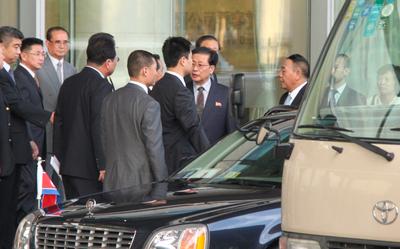The ambitious rocket and nuclear programs, which North Korea continues to pursue despite international condemnation, are expensive and harmful to its economy. International sanctions continue to bite the DPRK’s foreign trade and investment prospects. Regular floods and droughts, animal epidemics and other natural disasters hit the fragile economy even harder. According to expert estimations, the DPRK should have ceased to exist in the mid-1990s, after the Communist Bloc collapsed and Kim Il-sung died. But North Korea has come a long way toward recovering from the famine and even shows steady signs of economic growth.
Foreign critics have looked everywhere hoping to unravel the mystery. After 2008, stalled inter-Korean cooperation left North Korea without South Korean financial assistance. Western humanitarian aid has also been exhausted or reduced to a number of goods with little market value. Although the volume of North Korea’s foreign trade is negligible, the domestic economic situation continues to improve. Pyongyang is routinely suspected of violating international sanctions by trading arms, smuggling drugs, counterfeiting US dollars and other crimes. These activities would be expected to refill the impoverished state with badly needed foreign exchange. However, anti-proliferation operations and bank account arrests have never disclosed anything criminal nor did they manage to answer the main question: where does the money come from?
In fact, North Korea is sitting on a goldmine. It hosts sizeable deposits of more than 200 different minerals, of which deposits of coal, iron ore, magnesite, gold ore, zinc ore, copper ore, limestone, molybdenum, and graphite are the largest and have the potential for the development of large-scale mines. After China, North Korea’s magnesite reserves are the largest in the world, and its tungsten deposits are almost the sixth-largest in the world. Still the value of all these resources pales in comparison to prospects which promise the exploration and export of rare earth metals.
Rare earth metals (REM) are a group of 17 elements which are found in the earth’s crust. Known as ‘the vitamins of high-tech industries’, REMs are minerals necessary for making semiconductors, smartphones, LCDs, and notebook computers as well as being essential in manufacturing green technologies such as wind turbines, solar panels or hybrid cars. Other types of REMs can be used in building tanks and airplanes, missiles and lasers.
South Korea estimates the total value of the North’s mineral deposits at more than US$6 trillion. Not surprisingly, despite high political and security tensions, Seoul is showing a growing interest in developing REMs together with Pyongyang. In 2011, after receiving permission from the Ministry of Unification, officials from the Korea Resources Corporation visited North Korea twice to study the condition of a graphite mine. Together with their counterparts from the DPRK’s National Economic Cooperation Federation they had working-level talks at the Kaesong Industrial Complex on jointly digging up REMs in North Korea. An analysis of samples obtained in North Korea showed that the type of rare earth metals could be useful for manufacturing LCD panels and optical lenses.
Rare earth minerals are becoming increasingly expensive, as China, the world’s largest rare earth supplier, puts limits on its output and exports. In February China’s exports of rare earth metals exceeded the price of US$1 million per-ton, a nearly 900 per cent increase in prices from the preceding year. China, which controls more than 95 per cent of global production of rare earth metals, has an estimated 55 million tons in REM deposits. North Korea has up to 20 million tons of REM deposits, but does not have the technology to explore its reserves or to produce high-tech goods. Nevertheless, in 2009 the DPRK’s exports of rare metals to China stood at US$16 million, and as long as someone invests, exports will continue to expand.
This growing rise in REM prices and strong demand gives the young leader Kim Jong-Un a good chance to improve the economic standing of North Korea. Following the Gulf States’ and Russian example of catching the wind of rising oil prices in their sails, Pyongyang is likely to try and follow suit. The export of rare earth metals will replenish the state coffers, stimulate the loyalty of the elites to Kim Jong-un’s autocratic rule, and secure the growth of consumption among the ordinary people. Relations with South Korea, China and Japan are also likely to improve due to the large-scale cooperation on exploring, processing and utilising REMs — the mineral of the 21st century.
In order to explore its mineral resources and REMs and increase output and exports, Pyongyang needs international assistance through joint projects. South Korea has recently expressed interest and North Korea has been cooperating with China to explore mineral resources in the DPRK for many decades. But to take full advantage, perhaps Japan and Taiwan, who look for alternative REM supplies for their micro-processor and other cutting-edge industries, might also decide to contribute to the development of this economically promising venture.
Paradoxically, the promise of Kim Jong-il might soon come true and North Korea may become a ‘rich and powerful state’ — rich in natural resources and empowered by nuclear technologies. Might North Korea not need to go through a painful and potentially destabilising economic reform? With increased state revenue from REMs, the level of prosperity in the two halves of the divided Korean Peninsula may gradually start equalising, opening more opportunities for greater exchange and cooperation and reducing the fear of another war for unification.
Leonid Petrov is Lecturer in Korean Studies at the Faculty of Arts and Social Sciences, University of Sydney.

